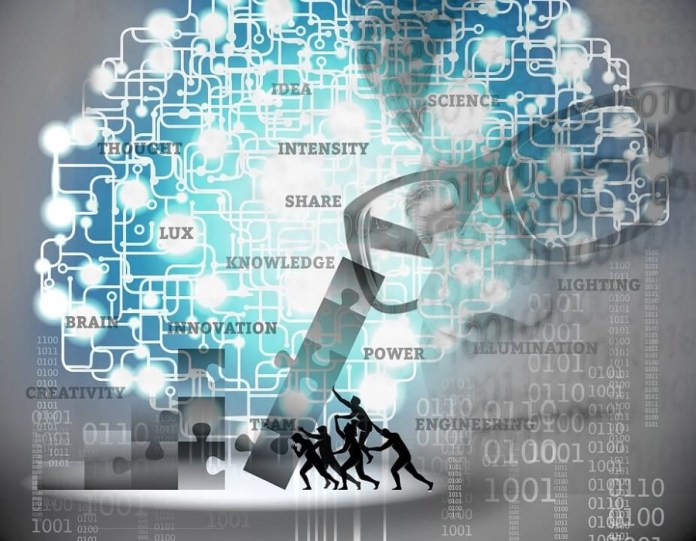It’s apparent that robotic technology is well-suited for many physical human tasks, ranging from the complex (cooking a restaurant meal) to tedious (scooping kitty litter).
But can it truly replace cognitive human tasks? Increasingly, the answer is “yes—sort of’; AI systems and robots still lack the highly developed sense of curiosity required to become truly intelligent.
That being said, cognitive automation solutions are arriving that “connect the dots” between large amounts of disparate data, to emulate learned human expertise and apply it in an automated fashion.
Automating repetitive tasks
Robotic process automation (RPA) presents the first step. An AI derivative, RPA can be described in numerous ways, most simply as “taking the robot out of the human.”
RPA reduces human efforts in mundane, repetitive tasks, significantly speeding them up while freeing humans to work on more high-value tasks that involve emotional intelligence, reasoning, judgment, analysis and customer interaction.
The New York Times recently reported that RPA software “is automating mundane office tasks in operations like accounting, billing, payments and customer service.
The programs can scan documents, enter numbers into spreadsheets, check the accuracy of customer records and make payments with a few automated computer keystrokes.”
In addition to alleviating repetitive physical tasks, RPA presents an opportunity for virtually all office tasks to become more accurate, and more efficient.
MORE – Top 50 RPA Tools & Software – A Comprehensive Guide
MORE – Data Science – 8 Powerful Applications
Improving business outcomes
While the Times article described RPA as “still in its infancy,” it is, in fact, a technology that has been deployed and developed over decades, in numerous domains including fraud management, and debt collection and recovery.
Here, advanced analytics and AI have been applied to dramatically reduce the amount of human physical and mental involvement required, resulting in greatly improved business outcomes. For example:
- Billions of payment card transactions worldwide are monitored for fraudulent activity; advanced analytic technology pinpoints the very few transactions that merit escalation to a human customer service representative. The most sophisticated fraud management solutions use AI and machine learning (ML) to rank flagged transactions with a numeric score and a set of reason codes; this explainable AI allows human analysts to understand exactly what the ML has uncovered.
Fraud management is one of the first commercial RPA applications. Since its debut in the early 1990s, credit card fraud has dropped more than 70%, despite vast growth and change in the global payment card landscape.
Fraud models continue to be enhanced with machine learning advanced analytic approaches such as collaborative profiling.
- In debt collection, mass calling (both human and automated) of delinquent accounts has been replaced with sophisticated risk stratification and targeting. Here, RPA allows human agents to focus on the accounts most likely to interact and provide payment. For example, a leading Australian bank used advanced debt management software to automate 75% of its collection cases, an approach that also produced, surprisingly, a very positive Net Promoter Score of 63.
These high levels of precision and customer satisfaction are achieved through ML and AI, a leap forward from the text analytics first used to automate debt collection 20 years ago.
This patented technology applied machine learning to analyze human conversations, using the insight to dramatically improve predictions of which customers were most likely to meet their debt obligation.
Connecting the dots with cognitive processes
On the near horizon, cognitive automation is bringing advanced AI-based humanistic attributes to RPA.
The key “ingredient” technology is cognitive analytics, which can significantly enhance applications as varied as anti-money laundering (AML), healthcare risk assessment and government intelligence.
Cognitive analytics integrates a number of intelligent individual processes (such as deep text analytics capabilities) using a comprehensive processing pipeline that merges various signals that can provide a much better result than individual components.
Specifically, cognitive analytics brings together natural language processing (NLP), text analytics, connected data analysis and AI to autonomously understand, reason and assist human users.
Additional algorithms implement natural language processing capabilities, blending them with text analytics features such that the cognitive system expresses insight to the rhythm and nuance of humans, as humans do among themselves.
These computational linguistic competencies and information retrieval abilities allow cognitive systems to “connect the dots” and address differences in human context in an adaptive, interactive manner.
Fighting money laundering
AML provides an excellent example of how cognitive technology can expand analytic efficacy from one fraud type — payment card fraud — into broader financial crimes.
The AI and predictive analytics that fight credit card fraud and other financial crimes are enhanced with cognitive analytics techniques, connecting risk across entities and transactions.
The cognitive solution searches for new suspicious patterns, including those that are relational, and provides compliance officers with detailed alerts meriting further investigation.
Uniquely, cognitive analytics can suggest what analysts should do next. This capability is invaluable in the fight against money laundering, which is extremely difficult for highly trained bank compliance officers to detect.
The estimated amount of money laundered globally in one year is a staggering 2-5% of global GDP, or $800 billion-$2 trillion in current US dollars.
Although cognitive process automation is in its infancy, great strides toward widespread adoption are being made daily.
As this innovative new technology gains speed, I’m confident that we will be able to use AI to “connect the dots” to solve new complex problems, much as we have in fraud and collections in decades past.




















